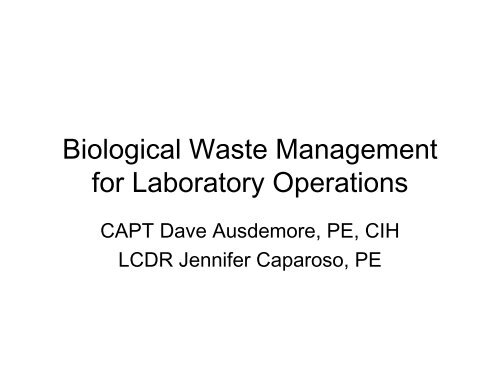Biological Waste Management for Laboratory Operations - Sandia ...
Biological Waste Management for Laboratory Operations - Sandia ... Biological Waste Management for Laboratory Operations - Sandia ...
- Page 2: Why Special Managementof Biological
- Page 5 and 6: Medical Waste (cont)• State Regul
- Page 7 and 8: Mixed Medical Waste/ChemicalWaste
- Page 9 and 10: Incineration• Thermal treatment-
- Page 11 and 12: Pathological Incinerator• Type 4
- Page 13 and 14: Field Incinerator• Used in field
- Page 15: Questions?
Why Special <strong>Management</strong>of <strong>Biological</strong> <strong>Waste</strong>s?
Medical <strong>Waste</strong>• Federal EPA Restrictions– Hospital/Infectious/Medical <strong>Waste</strong>Incinerators– Federal Insecticide, Fungicide andRodenticide Act (FIFRA)
Medical <strong>Waste</strong> (cont)• State Regulations• i.e. Georgia Environmental ProtectionDivision Chapter 391-3-4, Solid <strong>Waste</strong><strong>Management</strong>• Biomedical waste– Must be placed in containers impervious to moisture andresistant to ripping, tearing, or bursting– Must be red or orange in color & marked with “Biohazard”– Required to be treated prior to landfill– By-rule permits required <strong>for</strong> treatment• Sharps Disposal– placed in leakproof, rigid,puncture-resistand containers that are tightly sealed
Medical <strong>Waste</strong> (cont)• Other Special Restrictions– WHO Collaborative Center agreements• CDC is WHO Collaborating Center <strong>for</strong> PoxvirusDiagnosis and Research– Required to incinerate all smallpox waste– Biosafety in Microbiological and Biomedical<strong>Laboratory</strong> (BMBL)• BSL-4 <strong>Waste</strong> – required to be decontaminatedbe<strong>for</strong>e disposal by an approved method
Mixed Medical <strong>Waste</strong>/Chemical<strong>Waste</strong>• Inactivate biological agent, then disposeas chemical hazardous waste• Letter may be required <strong>for</strong> treatmentfacility• No red bags
<strong>Biological</strong> <strong>Waste</strong> Treatment• Autoclaved• Chemical Disinfection• Incineration
Incineration• Thermal treatment– Can destroy pathogens and toxins by hightemperatures• Reduce volume of original waste by 95+%– Significantly reduces amount of waste sent to landfill• <strong>Waste</strong> converted into ash, flue gases, and heat• Flue gases may be required to be cleaned ofpollutants be<strong>for</strong>e released to atmosphere• Incinerators need to be properly designed,constructed, operated, and maintained to protectenvironment and human health
Types of Incinerators• Pathological• Hospital/Medical/Infectious• Field
Pathological Incinerator• Type 4 <strong>Waste</strong>– Human and animal remains, anatomical parts and/ortissue, the bags/containers used to collected andtransport the waste, and animal bedding– Heating value: 1000 BTU/lb• Can burn up to 10% medical waste• Less stringent monitoring requirements andcontrols compared to medical waste incinerator– Monitor temperatures (primary and secondarychamber) and weights (per charge and lb/hr)• Incinerator requirements are dictated by airquality regulations
Hospital/Medical/Infectious<strong>Waste</strong> Incinerator• More stringent requirements than pathologicalincinerator (regulated by air quality laws)– More monitoring and control points– Per<strong>for</strong>mance testing– Operator training• Air Pollution Control Device (i.e., wet scrubber)• Not restricted to amount of medical waste thatcan be burned
Field Incinerator• Used in field during outbreak• Made out of 55 gallon drum• Diagram and instructions ti provided d inAnnex 12 of WHO “Guidelines <strong>for</strong>collection of clinical i l specimens during fieldinvestigation of outbreaks”
Incinerator “Best Practices”• Monitor <strong>Waste</strong> Types• Ensure Proper Operating Temperatures• Optimize i operation schedule
Questions?



